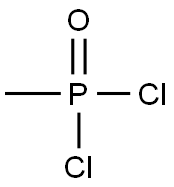
Метилфосфоновой дихлорид
- английское имяMETHYLPHOSPHONIC DICHLORIDE
- CAS №676-97-1
- CBNumberCB1391280
- ФормулаCH3Cl2OP
- мольный вес132.91
- EINECS211-634-4
- номер MDLMFCD00002071
- файл Mol676-97-1.mol
| Температура плавления | 31-34 °C |
| Температура кипения | 163 °C(lit.) |
| плотность | 1.468 g/mL at 25 °C(lit.) |
| давление пара | 760 mm Hg ( 163 °C) |
| Fp | >110°C |
| растворимость | Acetonitrile (Slightly), Chloroform |
| форма | solid |
| Растворимость в воде | Soluble in water. |
| Чувствительный | Moisture Sensitive |
| БРН | 1071305 |
| Стабильность | Stable, but may decompose in the presence of water or moisture. Incompatible with water, strong bases, strong oxidizing agents. |
| Справочник по базе данных CAS | 676-97-1 |
| Рейтинг продуктов питания EWG | 1 |
| FDA UNII | 2XGZ22DHQ2 |
| Система регистрации веществ EPA | Methylphosphonic dichloride (676-97-1) |
| Коды опасности | T+ | |||||||||
| Заявления о рисках | 14-26-34 | |||||||||
| Заявления о безопасности | 26-36/37/39-45 | |||||||||
| РИДАДР | UN 3390 6.1/PG 1 | |||||||||
| WGK Германия | 3 | |||||||||
| RTECS | TA1840000 | |||||||||
| F | 10 | |||||||||
| TSCA | Yes | |||||||||
| Класс опасности | 6.1 | |||||||||
| Группа упаковки | I | |||||||||
| Банк данных об опасных веществах | 676-97-1(Hazardous Substances Data) | |||||||||
| NFPA 704: |
|
рисовальное письмо(GHS)
-
рисовальное письмо(GHS)


-
сигнальный язык
опасность
-
вредная бумага
H314:При попадании на кожу и в глаза вызывает химические ожоги.
H330:Смертельно при вдыхании.
-
оператор предупредительных мер
P260:Не вдыхать газ/ пары/ пыль/ аэрозоли/ дым/ туман.
P271:Использовать только на открытом воздухе или в хорошо вентилируемом помещении.
P280:Использовать перчатки/ средства защиты глаз/ лица.
P303+P361+P353:ПРИ ПОПАДАНИИ НА КОЖУ (или волосы): Снять/удалить немедленно всю загрязненную одежду. Промыть кожу водой.
P304+P340+P310:ПРИ ВДЫХАНИИ: Свежий воздух, покой. Немедленно обратиться за медицинской помощью.
P305+P351+P338:ПРИ ПОПАДАНИИ В ГЛАЗА: Осторожно промыть глаза водой в течение нескольких минут. Снять контактные линзы, если Вы ими пользуетесь и если это легко сделать. Продолжить промывание глаз.
Метилфосфоновой дихлорид химические свойства, назначение, производство
Химические свойства
Methyl phosphonic dichloride is a low melting solid or colorless to pale yellow liquid. Pungent odor.Использование
suzuki reactionМетоды производства
The oxidation of lowvalency organophosphorus compounds is important mainly in the case of the thiophosphonic acid chlorides. This method is used in the production of methylphosphonic acid dichloride by reaction of methyldichlorophosphine with sulfuryl chloride or chlorosulfuric acid. Elemental sulfur reacts with MePCl2 in the presence of catalytic quantities of tetraalkylphosphonium salts to form methylthiophosphonic acid dichloride.Общее описание
Strongly irritates skin. Contact may destroy or irreversibly alter skin tissue. Very toxic by ingestion, inhalation, or by skin absorption. Combustible, though may be difficult to ignite.Реакции воздуха и воды
Fumes in moist air to form hydrogen chloride. Reacts with water to form hydrochloric acid, reaction may be violent.Профиль реактивности
METHYLPHOSPHONIC DICHLORIDE is incompatible with water, strong oxidizing agents, alcohols, bases (including amines).. May react vigorously or explosively if mixed with diisopropyl ether or other ethers in the presence of trace amounts of metal salts [J. Haz. Mat., 1981, 4, 291].Угроза здоровью
Poisonous if inhaled or swallowed. Contact causes severe burns to skin and eyes.Пожароопасность
METHYLPHOSPHONIC DICHLORIDE may burn but does not ignite readily. May ignite other combustible materials (wood, paper, oil, etc.). Reacts violently with water. Flammable poisonous gases may accumulate in tanks and hopper cars. Runoff to sewer may create fire or explosion hazard. Contact causes severe burns to skin and eyes. Runoff from fire control or dilution water may cause pollution. Violent reaction with water.Профиль безопасности
Poison by inhalation. A corrosive irritant to the eyes, skin, and mucous membranes. When heated to decomposition it emits toxic fumes of Cland POx.Возможный контакт
Highly flammable; mists or Vapors may form explosive mixture with air. Reacts with moist air forming fumes of hydrogen chloride; may spontaneously ignite. Reacts with water or alcohol, forming hydrochloric acid. The reaction may be violent and ignite unreacted material. Incompatible with oxidizers (chlorates, nitrates, peroxides, permanganates, perchlorates, chlorine, bromine, fluorine, etc.); contact may cause fires or explosions. Keep away from alkaline materials, strong bases, strong acids, oxoacids, epoxides, amines, ethers. May react violently, possibly explosively, when mixed with ethers and trace amounts of metal salts.Перевозки
UN9206 Methyl phosphonic dichloride, Hazard class: 6.1; Labels: 6.1-Poisonous materials, 8-Corrosive material. Domestic (United States), Inhalation Hazard Zone B. UN3390 Toxic by inhalation liquid, corrosive, n.o.s. with an LC50 # 1000 mL/m3 and saturated vapor concentration ≥ 10 LC50 Hazard Class: 6.1; Labels: 6.1- Poisonous materials, 8-Corrosive material, Technical Name Required, Inhalation Hazard Zone BМетоды очистки
Methylphosphonic dichloride [676-97-1] M 132.9, m 33o, 33-37o, b 53-54o/10mm, 64-6 7o/20.5mm, 86o/44mm, 162o/760mm, d 4 1.4382. Fractionally redistil it until the purity as checked by hydrolysis and acidimetry for Clis correct and the distillate should solidify on cooling. [Kinnear & Perren J Chem Soc 3437 1952, Crofts & Kosolapoff J Am Chem Soc 75 3379 1952, for IR see McIvor et al. Can J Chem 34 1611 1956, Beilstein 4 IV 3509.]Утилизация отходов
Use a licensed professional waste disposal service to dispose of this material. Dissolve or mix the material with a combustible solvent and burn in a chemical incinerator equipped with an afterburner and scrubber. All federal, state, and local environmental regulations must be observed